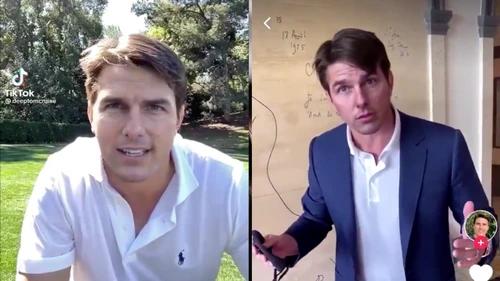
“I’m gonna show you some magic … It’s the real thing,” the fake Cruise says. “It’s all the real thing.”
There’s no question the videos are really good. When scanned through several of the best publicly available deepfake detection tools, they avoided discovery. That led many to claim that a new threshold had been reached in deepfake sophistication, and that social media would soon be overwhelmed with similar videos.
But that kind of analysis fails to take into account the amount of time, money, and skill it took to produce these videos.
They are the work of Belgian visual effects artist Chris Ume, who is part of a group known as Deep Voodoo Studio, a team of the world’s best deepfake artists assembled by the creators of the hit TV show “South Park,” Trey Parker and Matt Stone. The team worked with English actor Peter Serafinowicz to produce a 2020 YouTube show called “Sassy Justice,” which featured multiple deepfakes of celebrities and politicians.
The Tom Cruise TikTok videos required not only the expertise of Ume and his team but also the cooperation of Miles Fisher, a well-known Tom Cruise impersonator who was behind a viral video in 2019 that purported to show Cruise announcing his candidacy for the 2020 election.
Ume and Fisher worked together earlier this year on a follow-up to the Cruise 2020 video, with a deepfake of the actor “conceding” the election. Ume is credited on the YouTube video with providing the “deepfake” skills.
Ume has even detailed some of the highly complex and involved technical processes he had to go through to produce previous deepfakes.
So, while the Tom Cruise TikTok videos that went viral last week may look like they were created in minutes, the reality is that they took a lot of time, technical expertise, and the skilled performance of a real actor.
Rather than predicting a dark future of disinformation for the masses, they’re simply another example of what can be done with significant time and resources.
“The problem with coverage of the Tom Cruise video is that it over-emphasizes how easy it is to make a deepfake like this,” Sam Gregory, program director at human rights nonprofit Witness, told VICE News. “This is an excellent deepfake, made with effort, with an impersonator. We are simply not surrounded by deepfakes. We live in a world with a lot of shallowfakes — simple, miscontextualized, or edited videos.”
Deepfake technology has been hyped as a major threat over the past few years. Back in June 2019, experts warned the House Intelligence Committee that deepfakes were a menace to the 2020 presidential election.
Intelligence Committee Chair Adam Schiff even played a deepfake of Sen. Elizabeth Warren (D-Mass) and called on social media companies to take the threat seriously, because “after viral deepfakes have polluted the 2020 elections, by then it will be too late.” In October of that year, Facebook CEO Mark Zuckerberg told Congress that deepfake technology was an “emerging threat.”
Such warnings proved to be without merit during the 2020 elections. But now, they’re helping provide authoritarian regimes with an excuse to dismiss legitimate evidence of atrocities.
“All the rhetoric of ‘Seeing is no longer believing’ plays into the hands of authoritarians and conspiracy theorists who can use this to attack true footage,” Gregory said.
Recently, a workout video went viral when it accidentally captured a military coup in Myanmar. Even though it was real, many amateur online investigators dismissed it as a deepfake. And when President Donald Trump gave a sort-of concession speech, adherents of the QAnon conspiracy theory dismissed it as a sham.
Originally published at https://www.vice.com
